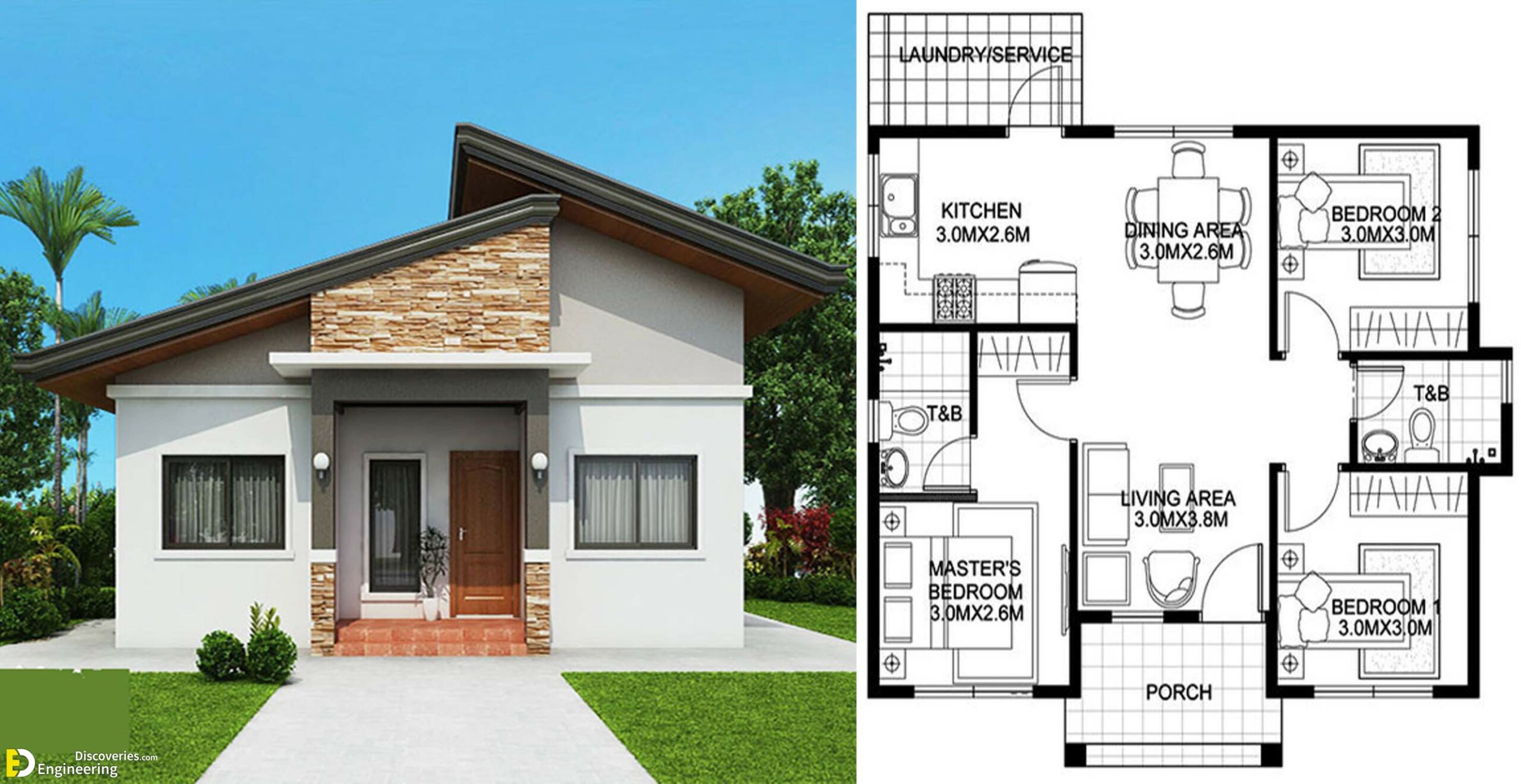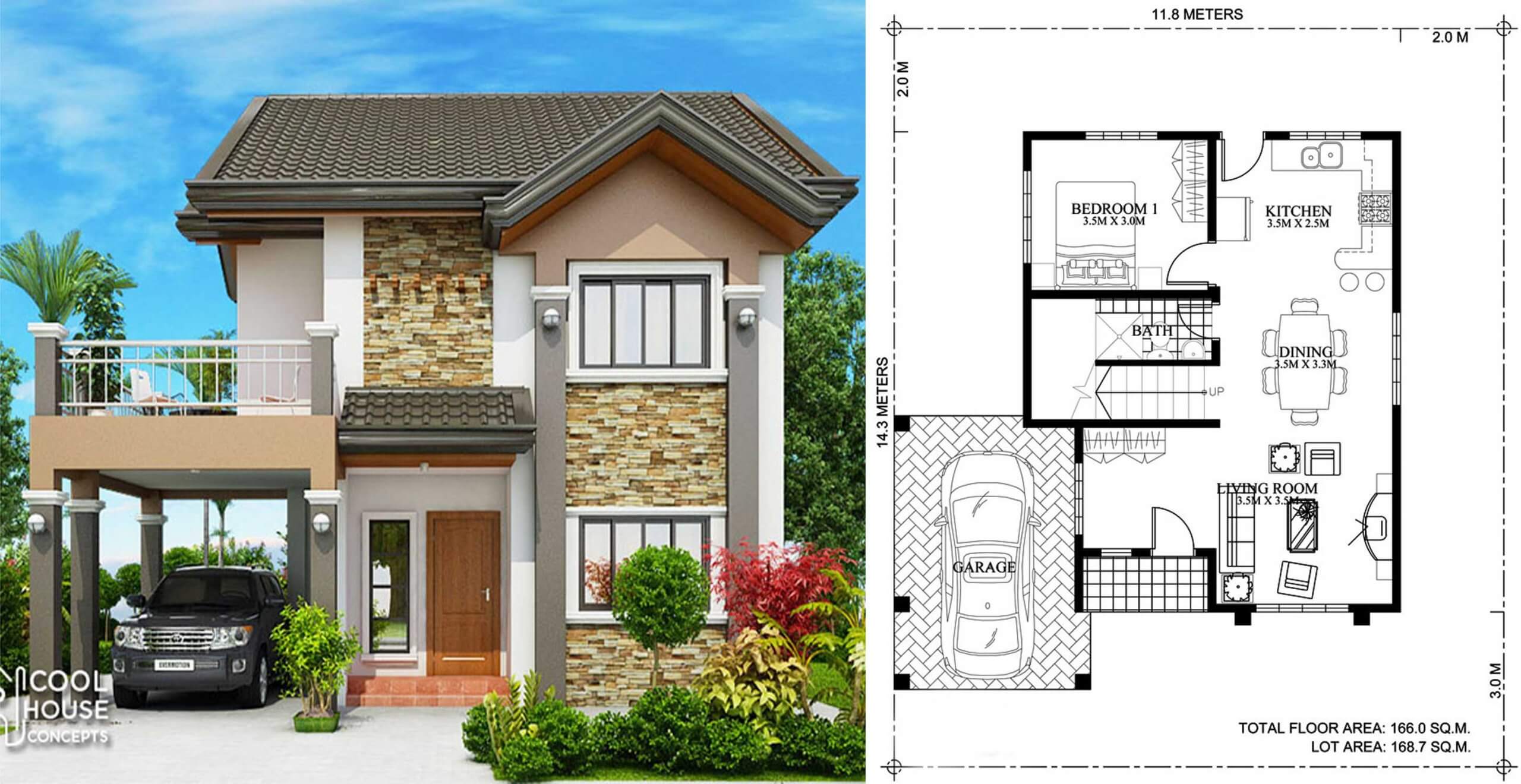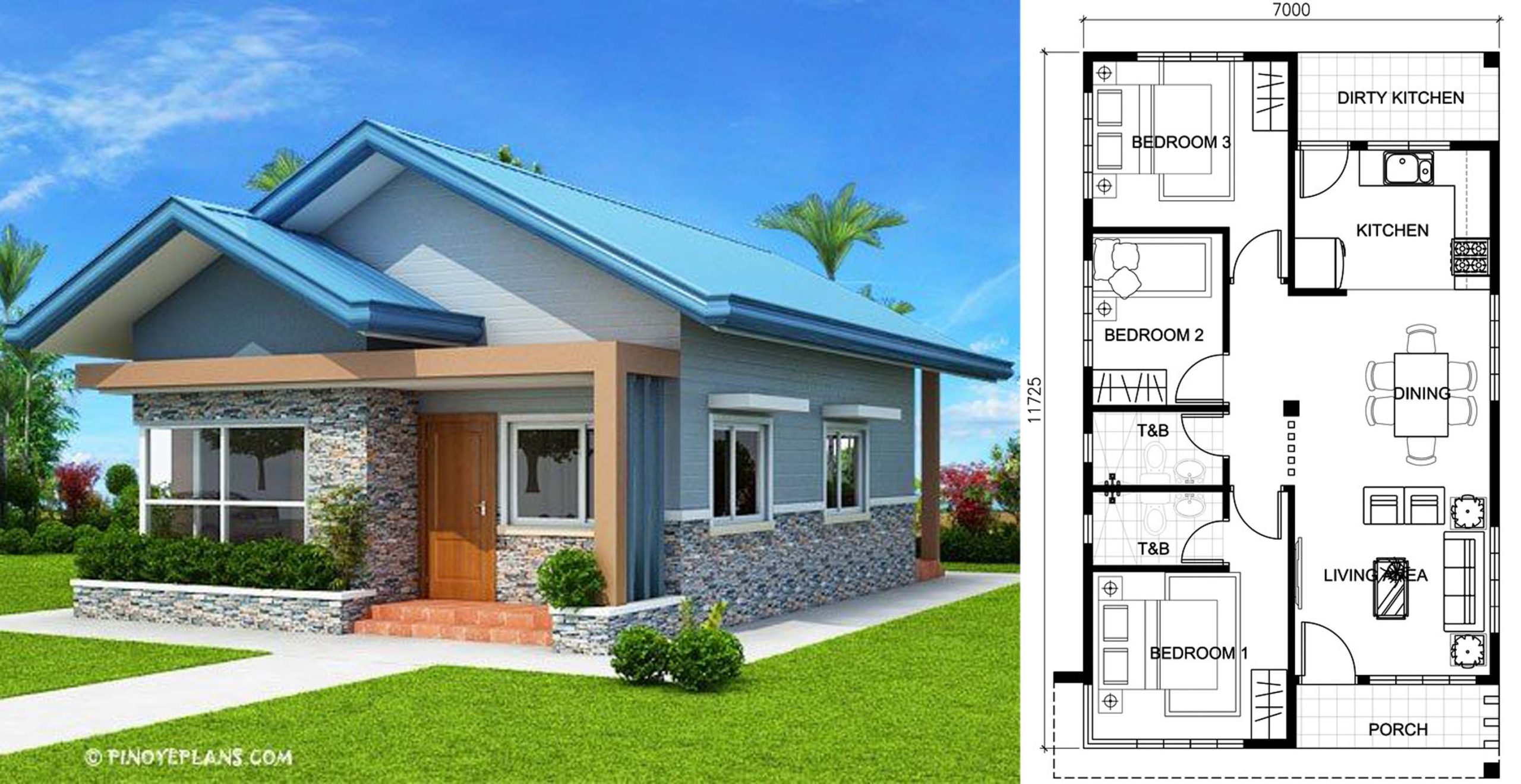Bungalow House Design Characteristics: Bungalow House With 3 Bedrooms Floor Plan

Bungalows are a popular architectural style known for their charming and cozy aesthetic. They originated in India and gained popularity in the early 20th century, particularly in the United States and Canada. These homes are characterized by their distinctive features, which set them apart from other architectural styles.
Defining Features of a Bungalow House
The defining features of a bungalow house include:
- Single Story: Bungalows are typically single-story homes, although some may have a partially finished attic or basement. This creates a spacious and open floor plan, ideal for families with young children or those seeking a more relaxed living style.
- Low-Pitched Roof: The roof of a bungalow is usually low-pitched, often with a wide overhang that provides shade and protection from the elements. This design element gives the home a distinctive, horizontal appearance.
- Large Front Porch: Bungalows often feature a large, inviting front porch that extends across the width of the house. This provides a space for relaxation, socializing, and enjoying the outdoors.
- Dormers: Dormers are small, roofed windows that project from the roofline. They add visual interest and provide additional light to the attic or upper level of a bungalow.
- Wide, Open Floor Plan: Bungalows typically have a wide, open floor plan, with few interior walls separating the living areas. This creates a sense of spaciousness and flow, making the home feel larger than it actually is.
Architectural Elements and Styles, Bungalow house with 3 bedrooms floor plan
Bungalows are known for their distinctive architectural elements and styles, which contribute to their charming and timeless appeal. These elements include:
- Craftsman Style: The Craftsman style, popular in the early 20th century, is a common bungalow variation. It emphasizes natural materials, such as wood and stone, and features exposed beams, built-in cabinetry, and a focus on functionality.
- Prairie Style: The Prairie style, developed by architect Frank Lloyd Wright, is another popular bungalow variation. It features horizontal lines, low-pitched roofs, and a strong connection to nature. Prairie style bungalows often have large windows, open floor plans, and a focus on simplicity and functionality.
- Spanish Colonial Revival: This style, inspired by Spanish colonial architecture, features stucco walls, red tile roofs, arched doorways, and courtyards. Spanish Colonial Revival bungalows often have a romantic and picturesque feel.
- Mediterranean Style: Mediterranean-style bungalows are characterized by their warm colors, terracotta roofs, and decorative details, such as wrought iron accents and tile floors. They often have a relaxed and inviting atmosphere.
Bungalow Variations and Unique Characteristics
There are many different variations of bungalow houses, each with its own unique characteristics. Some examples include:
- California Bungalow: This variation is characterized by its relaxed and informal style, often featuring a large front porch, a wide, open floor plan, and a connection to the outdoors.
- English Bungalow: English bungalows are known for their cozy and charming aesthetic, often featuring half-timbered construction, thatched roofs, and a focus on traditional details.
- Modern Bungalow: Modern bungalows update the traditional style with contemporary design elements, such as clean lines, open floor plans, and a focus on sustainability.
3-Bedroom Bungalow Floor Plan Considerations

Designing a 3-bedroom bungalow floor plan that optimizes space efficiency and functionality is crucial. The layout should be thoughtfully planned to create a comfortable and aesthetically pleasing living environment. This section will explore common layout options and best practices for designing a functional 3-bedroom bungalow floor plan.
Common Layout Options for Bedrooms, Living Areas, and Kitchens
The layout of a 3-bedroom bungalow floor plan can vary significantly depending on the size and shape of the lot, as well as the homeowner’s needs and preferences. However, some common layout options for bedrooms, living areas, and kitchens are frequently employed:
- Open Floor Plan: An open floor plan combines the living room, dining room, and kitchen into a single, spacious area. This layout creates a sense of openness and flow, making the home feel larger. The bedrooms are typically located in a separate wing of the house. This layout is popular in modern bungalows, offering flexibility in furniture arrangement and promoting a sense of community.
- Traditional Layout: A traditional layout features separate rooms for the living room, dining room, and kitchen. The bedrooms are typically located in a hallway off the living room. This layout offers privacy and separation between different areas of the house. It is often preferred by homeowners who value traditional aesthetics and a sense of order.
- Split-Level Layout: A split-level layout features a raised living area with a lower level that includes bedrooms and other rooms. This layout can be advantageous in homes with sloping lots or when maximizing natural light is a priority. It creates a distinct separation between living spaces and bedrooms, allowing for a greater sense of privacy.
Best Practices for Creating a Functional and Aesthetically Pleasing 3-Bedroom Bungalow Floor Plan
Several best practices can help create a functional and aesthetically pleasing 3-bedroom bungalow floor plan:
- Maximize Natural Light: Maximize natural light by strategically placing windows and doors to allow sunlight to penetrate the home throughout the day. Consider using large windows or skylights to enhance brightness and create a more airy atmosphere.
- Create a Flowing Layout: The layout should be designed to create a natural flow between rooms, making it easy to move between different areas of the house. This can be achieved by using open floor plans, strategic placement of doorways, and hallways that connect different rooms smoothly.
- Consider Traffic Patterns: Plan the layout to avoid congestion and create efficient traffic flow. Think about how people will move through the house, particularly in high-traffic areas such as the kitchen, hallways, and bathrooms. This will help ensure that the home is comfortable and functional for all occupants.
- Prioritize Storage Space: Incorporate ample storage space throughout the home, including closets, cabinets, and built-in shelves. This will help keep the home organized and clutter-free. A well-designed storage system will make the bungalow feel more spacious and less cluttered.
- Embrace the Bungalow Style: Consider the architectural features that define bungalow style, such as low-pitched roofs, wide porches, and simple detailing. Incorporate these elements into the floor plan to create a cohesive and aesthetically pleasing design.
Bungalow House with 3 Bedrooms

Bungalow homes with three bedrooms are a popular choice for families and individuals alike. These homes offer a comfortable and manageable living space, balancing functionality with a cozy ambiance. However, before deciding on a 3-bedroom bungalow, it’s essential to consider both its advantages and disadvantages.
Practical Considerations for a 3-Bedroom Bungalow
The decision to choose a 3-bedroom bungalow should be based on a thorough understanding of its practicality for your specific needs. This involves evaluating its suitability for families, individuals, and comparing it to other housing options.
Benefits of a 3-Bedroom Bungalow for Families
- Single-Level Living: A bungalow’s single-story design eliminates the need for stairs, making it ideal for families with young children or elderly members who may have mobility challenges. This eliminates the risk of falls and allows for easy access to all areas of the house.
- Lower Maintenance: A bungalow typically has a smaller footprint than a two-story house, reducing the overall maintenance workload. This translates to less time spent on yard work, cleaning, and repairs, freeing up time for family activities.
- Accessibility: The single-level design also makes a bungalow more accessible for people with disabilities. This feature can be particularly important for families who may need to accommodate a member with mobility limitations.
Challenges of a 3-Bedroom Bungalow for Families
- Limited Space: A 3-bedroom bungalow might feel cramped for large families, especially if they have multiple children or frequently host guests. The limited space can create challenges in managing belongings and accommodating everyone comfortably.
- Lack of Privacy: The open layout of a bungalow can sometimes lead to a lack of privacy. This can be a concern for teenagers who may want their own space or for families who need quiet time for work or study.
- Limited Storage: While a bungalow offers ample living space, storage can be a challenge. A smaller footprint often means less space for closets and built-in storage solutions, requiring creative solutions for organizing belongings.
Benefits of a 3-Bedroom Bungalow for Individuals
- Low Maintenance: A single-story design means less time spent on yard work, cleaning, and repairs, allowing individuals to focus on their hobbies or other pursuits.
- Easy Accessibility: The absence of stairs makes a bungalow accessible for individuals with mobility limitations, ensuring they can easily navigate their home and enjoy their independence.
- Comfortable and Cozy: The smaller footprint and single-story design can create a cozy and intimate atmosphere, perfect for individuals who prefer a more relaxed and comfortable living environment.
Challenges of a 3-Bedroom Bungalow for Individuals
- Potential for Feeling Claustrophobic: A smaller footprint can sometimes feel confining for individuals who value spaciousness and open areas. The limited space may create a sense of claustrophobia, especially if they enjoy having guests or working from home.
- Lack of Personal Space: A 3-bedroom bungalow may not offer enough personal space for individuals who desire separate areas for work, hobbies, or relaxation. The limited space can make it challenging to create dedicated zones for different activities.
- Limited Growth Potential: A bungalow’s smaller size may not be ideal for individuals who anticipate future growth, such as expanding their family or needing more space for work or hobbies. The limited space can restrict their ability to adapt to changing needs.
Comparing a 3-Bedroom Bungalow to Other Home Types
- Townhouse: A townhouse offers similar living space to a bungalow but with the added advantage of a shared wall, potentially reducing heating and cooling costs. However, townhouses may have limited outdoor space and less privacy compared to a freestanding bungalow.
- Two-Story House: A two-story house provides more living space and privacy than a bungalow. However, it comes with the added expense of stairs, higher maintenance costs, and potential accessibility challenges.
- Ranch-Style House: A ranch-style house is similar to a bungalow in terms of single-level living and low maintenance. However, ranch houses typically have a larger footprint, offering more space for families and individuals who desire a spacious living environment.
Bungalow house with 3 bedrooms floor plan – A bungalow house with 3 bedrooms offers a cozy and efficient layout, ideal for families or individuals seeking a comfortable living space. While designing the bathroom, consider incorporating modern bathroom towel hooks for a stylish and practical touch. These hooks not only enhance the aesthetics but also provide a convenient solution for keeping towels organized and readily accessible.
With a well-planned bungalow floor plan, you can create a harmonious and functional home that meets your specific needs and preferences.
A bungalow house with 3 bedrooms provides ample space for a family, with each bedroom offering its own cozy retreat. The bathroom, a vital part of any home, requires thoughtful planning, including the placement of practical accessories like a bathroom hand towel hook.
This simple detail ensures convenience and adds a touch of elegance to the overall design, reflecting the bungalow’s charming and functional nature.